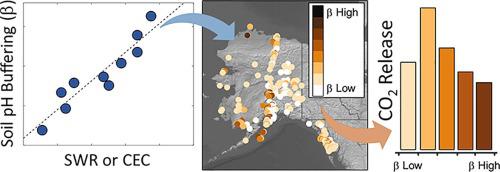Geoderma ( IF 6.1 ) Pub Date : 2022-06-18 , DOI: 10.1016/j.geoderma.2022.116003 Jianqiu Zheng , Erin C. Berns-Herrboldt , Baohua Gu , Stan D. Wullschleger , David E. Graham

|
Dynamic pH change promoted by biogeochemical reactions in Arctic tundra soils can be a major control on the production and release of CO2 and CH4, which contribute to rising global temperatures. Large quantities of soil organic matter (SOM) in these soils are susceptible to microbial decomposition, leading to pH changes during permafrost thaw. Soil pH buffering capacity (β) modulates the extent of pH change but has not been thoroughly studied and represented in predictive ecosystem scale biogeochemical models in Arctic tundra soils. In this study, we generated titration curves for 21 acidic tundra soils from three Arctic sites across northern Alaska, United States of America. Geochemical and hydrological soil properties were evaluated, and correlations with β were developed. Strong correlations between β and both gravimetric water content (Θg) (R2 = 0.847, p < 0.001) and soil water retention (SWR) (R2 = 0.849, p = 0.001) indicate that the ability of soil to retain water could be associated with its buffering properties. Correlations between β and soil organic carbon (SOC) and cation exchange capacity (CEC) were also explored, and relationships to SWR are discussed. These correlations were then used with existing soil databases reporting SOC, CEC, and SWR to estimate β across Alaska soils. We further demonstrated the quantitative relationships between β and the simulated rates of biogeochemical reactions and show that lower β leads to higher soil pH and more CH4 production. Our study provides simple proxies for β in Arctic soils and highlights the importance and implications of representing soil buffering in predictive models, thereby enabling quantitative coupling between pH dynamics associated with biogeochemical reactions. Integrating β into predictive models of Arctic biogeochemical cycling may reduce model uncertainty and further our understanding of permafrost SOM degradation accelerated by warming.
中文翻译:

量化酸性、富含有机物的北极土壤的 pH 缓冲能力:可测量的替代指标和对土壤碳降解的影响
北极苔原土壤中生物地球化学反应促进的动态 pH 变化可能是控制 CO 2和 CH 4产生和释放的主要因素,这导致全球气温上升。这些土壤中的大量土壤有机质 (SOM) 易受微生物分解,导致永久冻土融化期间的 pH 值变化。土壤 pH 缓冲能力 (β) 调节 pH 变化的程度,但尚未在北极苔原土壤的预测生态系统规模生物地球化学模型中进行彻底研究和表示。在这项研究中,我们生成了来自美国阿拉斯加北部三个北极地区的 21 种酸性苔原土壤的滴定曲线。评估了地球化学和水文土壤性质,并建立了与 β 的相关性。β 与重量含水量 (Θ g ) (R 2 = 0.847, p < 0.001) 和土壤保水性 (SWR) (R 2 ) 之间的强相关性 = 0.849, p = 0.001)表明土壤保水能力可能与其缓冲特性有关。还探讨了 β 与土壤有机碳 (SOC) 和阳离子交换容量 (CEC) 之间的相关性,并讨论了与 SWR 的关系。然后将这些相关性与报告 SOC、CEC 和 SWR 的现有土壤数据库一起使用,以估计阿拉斯加土壤中的 β。我们进一步证明了 β 与模拟的生物地球化学反应速率之间的定量关系,并表明较低的 β 导致较高的土壤 pH 值和更多的 CH 4生产。我们的研究提供了北极土壤中 β 的简单代理,并强调了在预测模型中表示土壤缓冲的重要性和意义,从而实现与生物地球化学反应相关的 pH 动态之间的定量耦合。将 β 整合到北极生物地球化学循环的预测模型中可以减少模型的不确定性,并进一步加深我们对变暖加速的永久冻土 SOM 退化的理解。


























 京公网安备 11010802027423号
京公网安备 11010802027423号